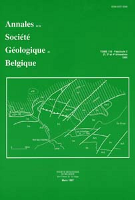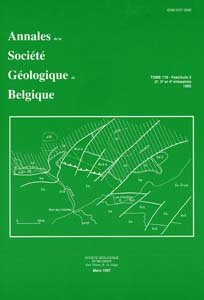- Home
- Volume 105 (1982)
- Fascicule 1
- Hydrothermal assemblages of aluminian serpentine, florencite and kyanite in the Zairian Copperbelt
View(s): 471 (6 ULiège)
Download(s): 810 (5 ULiège)
Hydrothermal assemblages of aluminian serpentine, florencite and kyanite in the Zairian Copperbelt

Résumé
Plusieurs occurrences de disthène, serpentine aluminifère et florencite ont été observées dans le "Copperbelt" du Zaïre, le long d'une bande étroite comprise dans la zone à chlorite de l'arc lufilien. Elles résulteraient d'une altération hydrothermale de sédiments appartenant au "Roan Supergroup" et consisteraient en le remplacement d'un clinochlore néogène par un ensemble complexe comportant de la serpentine aluminifère, de la smectite et des interstratifiés chlorite-talc et chlorite-montmorillonite. Cette altération remplacerait également une monazite diagénétique, riche en cérium et lanthane, par une monazite essentiellement cérifère et une florencite riche en lanthane. La présence de disthène, parmi les minéraux argileux, pourrait être attribuée à des conditions locales de haute pression engendrée par une bréchification intense des sédiments du "Roan Supergroup". Ces manifestations locales de haute pression semblent confirmées par l'existence d'autres associations de haute pression, comme celle à phengite - chlorite - phlogopite - disthène observée dans la zone à biotite de l'arc lufilien. Ces observations et l'interprétation qui en découle peuvent être rapprochées des récentes découvertes, en Zambie, de roches à faciès "white schist" et autres associations de haute pression, localisées dans une portion plus méridionale de l'arc lufilien.
Abstract
Several occurrences of kyanite - aluminian serpentine - florencite have been observed in the Zairian Copperbelt in a narrow band located in the chlorite zone of the Lufilian metamorphic belt. These occurrences are interpreted as the result of hydrothermal alteration of sediments belonging to the Roan Supergroup. This alteration resulted in the replacement of a neogenic clinochlore by a complex series consisting of aluminian serpentine, smectite, chlorite-talc and interstratified chlorite-montmorillonite. This alteration also replaced a diagenetic monazite containing cerium and lanthanum by a monazite containing essentially cerium and a florencite rich in lanthanum. The presence of kyanite among the clay minerals is tentatively attributed to local high pressure conditions caused by the intense brecciation of the sedimentary rock of the Roan Supergroup. Occurrences of local high pressures are apparently confirmed by the existence of high pressure assemblages such as phengite – chlorite – phlogopite - kyanite in the biotite zone of the Lufilian belt. These observations and resulting interpretation may be paralleled with the recent discoveries in Zambia of "whiteschists" and other high pressure assemblages located in the Lufilian belt just south of the area being studied.
To cite this article
About: J.J. Lefebvre
UMEX Inc., 1935 Leslie St., Don Mills, Toronto, Ontario, Canada - M3B 2MS
About: L.E. Patterson
UMEX Inc., 1935 Leslie St., Don Mills, Toronto, Ontario, Canada - M3B 2MS






